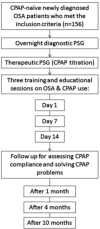Long-term compliance with continuous positive airway pressure in Saudi patients with obstructive sleep apnea. A prospective cohort study
- PMID: 26219440
- PMCID: PMC4549586
- DOI: 10.15537/smj.2015.8.11716
Long-term compliance with continuous positive airway pressure in Saudi patients with obstructive sleep apnea. A prospective cohort study
Abstract
Objectives: To evaluate continuous positive airway pressure (CPAP) compliance and define predictors of CPAP compliance among Saudi patients with obstructive sleep apnea (OSA) after applying an educational program.
Methods: This prospective cohort study included consecutive patients diagnosed to have OSA based on polysomnography between January 2012 and January 2014 in King Saud University, Riyadh, Kingdom of Saudi Arabia. All patients had educational sessions on OSA and CPAP therapy before sleep study, and formal hands-on training on CPAP machines on day one, day 7, and day 14 after diagnosis. The follow-up in the clinic was carried out at one, 4, and 10 months after initiating CPAP therapy. Continuous positive airway pressure compliance was assessed objectively. Logistic regression model was used to assess the predictors of CPAP adherence.
Results: The study comprised 156 patients with a mean age of 51.9±12.1 years, body mass index of 38.4±10.6 kg/m2, and apnea hypopnea index of 63.7±39.3 events/hour. All patients were using CPAP at month one, 89.7% at month 4, and 83% at month 10. The persistence of CPAP-related side effects and comorbid bronchial asthma remained as independent predictors of CPAP compliance at the end of the study.
Conclusion: With intensive education, support, and close monitoring, more than 80% of Saudi patients with OSA continued to use CPAP after 10 months of initiating CPAP therapy.
Figures


References
-
- Kushida CA, Littner MR, Hirshkowitz M, Morgenthaler TI, Alessi CA, Bailey D, et al. Practice parameters for the use of continuous and bilevel positive airway pressure devices to treat adult patients with sleep-related breathing disorders. Sleep. 2006;29:375–380. - PubMed
-
- Sleep-related breathing disorders in adults: recommendations for syndrome definition and measurement techniques in clinical research. The Report of an American Academy of Sleep Medicine Task Force. Sleep. 1999;22:667–689. - PubMed
-
- Bahammam AS, Al-Rajeh MS, Al-Ibrahim FS, Arafah MA, Sharif MM. Prevalence of symptoms and risk of sleep apnea in middle-aged Saudi women in primary care. Saudi Med J. 2009;30:1572–1576. - PubMed
-
- BaHammam AS, Alrajeh MS, Al-Jahdali HH, BinSaeed AA. Prevalence of symptoms and risk of sleep apnea in middle-aged Saudi males in primary care. Saudi Med J. 2008;29:423–426. - PubMed
Publication types
MeSH terms
LinkOut - more resources
Full Text Sources
Other Literature Sources

